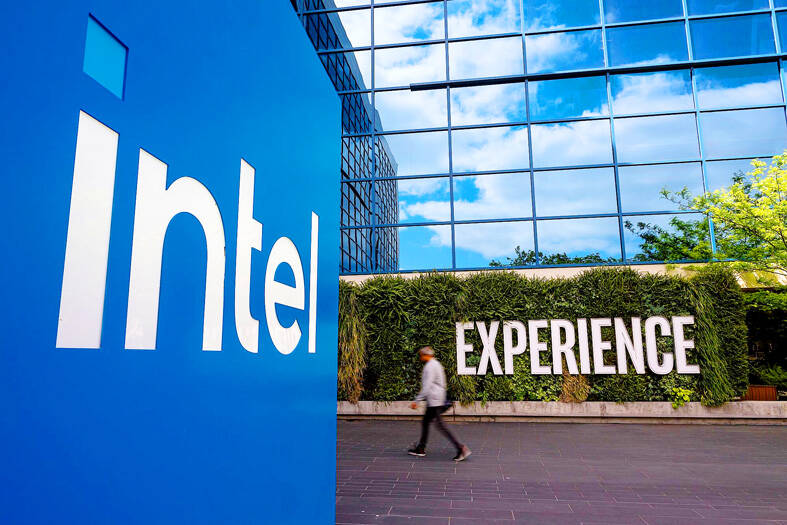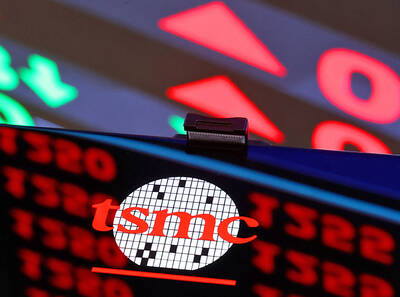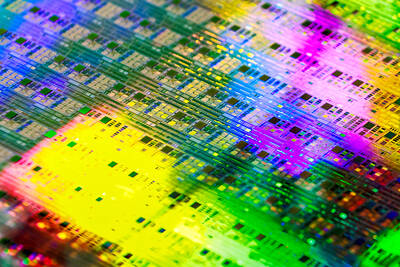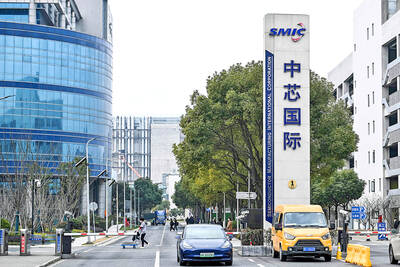Intel Corp CEO Lip-Bu Tan (陳立武) on Thursday gave investors a stark diagnosis of the chipmaker’s problems, along with the sense that it would take a while to fix them.
Intel’s bureaucratic corporate culture needs a shake-up, Tan said, so he is going to cut jobs, remove layers of management and force everyone back to the office. His prescriptions for other areas of malaise — such as Intel’s struggling foundry business — were more vague.
What is most clear is Intel’s short-term woes are even worse than feared. The company gave a revenue forecast for the current quarter that was well below what analysts projected and its chief financial officer said that a tariff-fueled recession could torpedo chip demand.

Photo: Bloomberg
The grim outlook sent Intel shares sliding more than 5 percent in late trading.
“Even with costs cuts and strategic moves, Intel still faces several external challenges, namely increasing competition, lack of competitive products within AI [artificial intelligence] markets and no meaningful customers for its foundry business,” Edward Jones analyst Logan Purk said in a note. “This was a disappointing quarter for Intel and continues its string of weaker earnings results.”
Tan, a 65-year-old chip industry veteran, took the chief executive job last month. The board hired him after predecessor Pat Gelsinger struggled to restore the competitiveness of Intel’s products. Gelsinger was ousted late last year after sliding sales and mounting red ink doomed his comeback bid.
A bright spot for Intel: First-quarter sales came in at US$12.7 billion, topping predictions. The chipmaker follows Texas Instruments Inc in delivering stronger results for that period than analysts had projected, but Intel’s weak forecast suggests that the uptick was just a blip — driven at least in part by a rush of orders ahead of looming tariffs being threatened by the US, China and others.
“The current macro environment is creating elevated uncertainty across the industry, which is reflected in our outlook,” Intel chief financial officer David Zinsner said in the earnings report.
Zinsner said he does not have an estimate for the size of the workforce reduction.
In a separate memo to employees, Tan said he wanted to change the company’s culture. That includes requiring staff to work in-person four days a week starting on Sept. 1.
“Our existing policy is that our hybrid employees should spend approximately three days per week on site,” Tan said. “Adherence to this policy has been uneven at best. I strongly believe that our sites need to be vibrant hubs of collaboration that reflect our culture in action.”
He said the layoffs would begin this quarter.
“We must balance our reductions with the need to retain and recruit key talent,” Tan said. “These decisions will not be made lightly.”
Second-quarter revenue would be between US$11.2 billion and US$12.4 billion, the company said. That compared with a US$12.9 billion average analyst estimate.
In the first quarter, Intel had losses per share of US$0.19. Analysts estimated losses per share of US$0.22 on sales of US$12.31 billion.
Intel’s annual revenue last year was down about US$26 billion from its peak in 2021. It is now less than half the size of Nvidia Corp by that measure and analysts are not predicting a rapid rebound anytime soon.
Looking ahead, the company is concerned that consumer spending and investment in areas such as data center infrastructure might decline. Uncertainty about tariffs is making the environment harder to predict and prompted Intel to offer a wider range of sales forecasts.

SEMICONDUCTOR SERVICES: A company executive said that Taiwanese firms must think about how to participate in global supply chains and lift their competitiveness Taiwan Semiconductor Manufacturing Co (TSMC, 台積電) yesterday said it expects to launch its first multifunctional service center in Pingtung County in the middle of 2027, in a bid to foster a resilient high-tech facility construction ecosystem. TSMC broached the idea of creating a center two or three years ago when it started building new manufacturing capacity in the US and Japan, the company said. The center, dubbed an “ecosystem park,” would assist local manufacturing facility construction partners to upgrade their capabilities and secure more deals from other global chipmakers such as Intel Corp, Micron Technology Inc and Infineon Technologies AG, TSMC said. It

NO BREAKTHROUGH? More substantial ‘deliverables,’ such as tariff reductions, would likely be saved for a meeting between Trump and Xi later this year, a trade expert said China launched two probes targeting the US semiconductor sector on Saturday ahead of talks between the two nations in Spain this week on trade, national security and the ownership of social media platform TikTok. China’s Ministry of Commerce announced an anti-dumping investigation into certain analog integrated circuits (ICs) imported from the US. The investigation is to target some commodity interface ICs and gate driver ICs, which are commonly made by US companies such as Texas Instruments Inc and ON Semiconductor Corp. The ministry also announced an anti-discrimination probe into US measures against China’s chip sector. US measures such as export curbs and tariffs

The US on Friday penalized two Chinese firms that acquired US chipmaking equipment for China’s top chipmaker, Semiconductor Manufacturing International Corp (SMIC, 中芯國際), including them among 32 entities that were added to the US Department of Commerce’s restricted trade list, a US government posting showed. Twenty-three of the 32 are in China. GMC Semiconductor Technology (Wuxi) Co (吉姆西半導體科技) and Jicun Semiconductor Technology (Shanghai) Co (吉存半導體科技) were placed on the list, formally known as the Entity List, for acquiring equipment for SMIC Northern Integrated Circuit Manufacturing (Beijing) Corp (中芯北方積體電路) and Semiconductor Manufacturing International (Beijing) Corp (中芯北京), the US Federal Register posting said. The

India’s ban of online money-based games could drive addicts to unregulated apps and offshore platforms that pose new financial and social risks, fantasy-sports gaming experts say. Indian Prime Minister Narendra Modi’s government banned real-money online games late last month, citing financial losses and addiction, leading to a shutdown of many apps offering paid fantasy cricket, rummy and poker games. “Many will move to offshore platforms, because of the addictive nature — they will find alternate means to get that dopamine hit,” said Viren Hemrajani, a Mumbai-based fantasy cricket analyst. “It [also] leads to fraud and scams, because everything is now